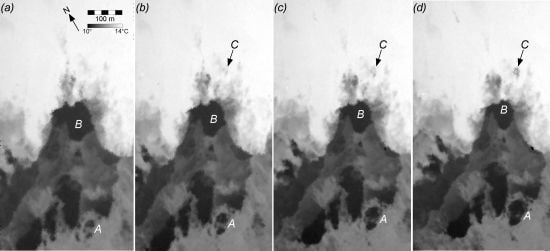Surface Imprints of Water-Column Turbulence: A Case Study of Tidal Flow over an Estuarine Sill
Abstract
:1. Introduction
2. Approach
2.1. Study Site Background
2.2. Satellite Imagery
2.3. Airborne Measurements
3. Results
3.1. Satellite Imagery
3.2. Daytime Aircraft Imagery
3.3. Nighttime Aircraft IR Imagery
3.4. Spatial Distribution of Boils
4. Discussion
4.1. Comparison with the Expected Flow Response
4.2. Comparison with a “Boil-Surfacing” Model
5. Conclusions
- (1)
- Turbulence reaching the sea surface as boils is captured in both thermal and visible imagery.
- (2)
- Boils appear as relative cold patches where upwelled water displaces an ambient diurnal warm layer. The contrast ranges from about 0.4 °C (under wind speeds of ∼5 m/s) to 1.8 °C (∼2 m/s).
- (3)
- High-resolution multi-looks, made possible by using a high framing-rate IR camera and by mechanically staring at a particular patch of the sea surface, are able to resolve the growth rate of a boil. A representative large boil grows at a sustained rate of ∼60 m2/s, attaining an areal extent of 3,750 m2 (an equivalent diameter of 70 m) after one minute.
- (4)
- Boils show an enhanced remote sensing reflectance over wavelengths of about 500 to 550 nm. This green-shift is consistent with light backscattering from large submerged “clouds” of air bubbles.
- (5)
- The data suggest that bubble clouds develop through the re-distribution of locally injected bubbles (from breaking of surface waves) by an underlying volume of turbulent flow.
- (6)
- Compared with an existing physical framework, unexpected differences in the spatial extent of surface turbulence occur at the same stage in tidal forcing, suggesting a dependence on some other factor, as yet undetermined.
- (7)
- The occurrence of boils within a few hundred meters downstream of the sill can be tentatively ascribed to vorticity generation at the sill crest. This appears to be a mechanism for vertical mixing not previously identified for the study area, and is an example where in-water measurements coupled with remote sensing data are needed to progress.
- (8)
- Intense ocean turbulence manifests itself on many spatial scales, and the time scale of large turbulent structures is measured in minutes. Such phenomena are difficult to measure directly, making remote sensing especially useful. Visible and thermal data have provided a starting point for understanding sill-induced turbulence. Synthetic aperture radar imagery, which can measure the surface roughness pattern and the surface current field at high spatial resolution [32–34], might be used to quantify the wave-current interaction and kinetic energy associated with the surface turbulence; and multi-look satellite imagery might be used to measure the boil growth rate.
Acknowledgments
Conflict of Interest
References
- Thorpe, S.A. Recent developments in the study of ocean turbulence. Annu. Rev. Earth Planet. Sci 2004, 32, 91–109. [Google Scholar] [Green Version]
- Marmorino, G.O.; Toporkov, J.V.; Smith, G.B.; Sletten, M.A.; Perkovic, D.; Frasier, S.; Judd, K.P. Ocean mixed-layer depth and current variation estimated from imagery of surfactant streaks. IEEE Geosci. Remote Sens. Lett 2007, 4, 364–367. [Google Scholar] [Green Version]
- Nimmo Smith, W.A.M.; Thorpe, S.A.; Graham, A. Surface effects of bottom-generated turbulence in a shallow tidal sea. Nature 1999, 400, 251–254. [Google Scholar] [Green Version]
- Thorpe, S.A.; Green, J.A.M.; Simpson, J.H.; Osborn, T.R.; Nimmo Smith, W.A.M. Boils and turbulence in a weakly stratified shallow tidal sea. J. Phys. Oceanogr 2008, 38, 1711–1730. [Google Scholar] [Green Version]
- Pawlowicz, R. Quantitative visualization of geophysical flows using digital oblique time-lapse imaging. IEEE J. Ocean. Eng 2003, 28, 699–710. [Google Scholar] [Green Version]
- Hennings, I.; Herbers, D. Radar imaging mechanism of marine sand waves at very low grazing angle illumination caused by unique hydrodynamic interactions. J. Geophys. Res. 2006, 111. [Google Scholar] [CrossRef]
- Chickadel, C.C.; Horner-Devine, A.R.; Talke, S.A.; Jessup, A.T. Vertical boil propagation from a submerged estuarine sill. Geophys. Res. Lett. 2009, 36. [Google Scholar] [CrossRef]
- Marmorino, G.O.; Smith, G.B. Thermal remote sensing of estuarine spatial dynamics: Effects of bottom-generated vertical mixing. Estuar. Coast. Shelf Sci 2008, 78, 587–591. [Google Scholar] [Green Version]
- Farmer, D.M.; D’Asaro, E.A.; Trevorrow, M.V.; Daikiri, G.T. Three-dimensional structure in a tidal convergence front. Cont. Shelf Res 1995, 15, 1649–1673. [Google Scholar] [Green Version]
- Farmer, D.M.; Pawlowicz, R.; Jiang, R. Tilting separation flows: A mechanism for intense vertical mixing in the coastal ocean. Dyn. Atmos. Ocean 2002, 36, 43–58. [Google Scholar] [Green Version]
- Chang, M.-H.; Lien, R.-C.; Yang, Y.J.; Tang, T.Y.; Wang, J. A composite view of surface signature and interior properties of nonlinear internal waves: Observations and applications. J. Atmos. Ocean. Technol 2008, 25, 1218–1227. [Google Scholar] [Green Version]
- Da Silva, J.C.B.; Magalhaes, J.M.; Batista, M.; Gostiaux, L.; Gerkema, T.; New, A.L. The EUFAR Transnational Access Project A.NEW (Airborne Observations of Nonlinear Evolution of Internal Waves Generated by Internal Tidal Beams). Proceedings of 2012 IEEE International Geoscience and Remote Sensing Symposium (IGARSS), Munich, Germany, 22–27 July 2012; pp. 7601–7604.
- Baschek, B.; Farmer, D.M.; Garrett, C. Tidal fronts and their role in air-sea gas exchange. J. Mar. Res 2006, 64, 483–515. [Google Scholar] [Green Version]
- Baschek, B. Air-Sea Gas Exchange in Tidal Fronts; Ph.D. Thesis, University of Victoria, Victoria, BC, Canada; 2003; p. 156. [Google Scholar]
- Farmer, D.M.; Armi, L. Maximal two-layer exchange over a sill and through the combination of a sill and contraction with barotropic flow. J. Fluid Mech 1986, 164, 53–76. [Google Scholar] [Green Version]
- Armi, L.; Farmer, D.M. Stratified flow over topography: Bifurcation fronts and transition to the uncontrolled state. Proc. Roy. Soc. A 2002, 458, 513–538. [Google Scholar] [Green Version]
- Largier, J.L. Tidal intrusion fronts. Estuaries 1992, 15, 26–39. [Google Scholar] [Green Version]
- Davies, A.M.; Xing, J. On the influence of stratification and tidal forcing upon mixing in sill regions. Ocean Dyn 2007, 57, 431–451. [Google Scholar] [Green Version]
- Klymak, J.M.; Gregg, M.C. Tidally generated turbulence over the knight inlet sill. J. Phys. Oceanogr 2004, 34, 1135–1151. [Google Scholar] [Green Version]
- Cummins, P.F.; Armi, L. Upstream internal jumps in stratified sill flow: Observations of formation, evolution, and release. J. Phys. Oceangr 2010, 40, 1419–1426. [Google Scholar] [Green Version]
- Pawlowicz, R. Observations and linear analysis of sill-generated internal tides and estuarine flow in Haro Strait. J. Geophys. Res 2002, 107, 2156–2202. [Google Scholar] [Green Version]
- Gargett, A.E. Generation of internal waves in the Strait of Georgia, British Columbia. Deep-Sea Res 1976, 23, 17–20. [Google Scholar] [Green Version]
- Wang, C. Geophysical Observations of Nonlinear Internal Solitary-Like Waves in the Strait of Georgia; Ph.D. Thesis, University British Columbia, Vancouver, BC, Canada; 2009; p. 156. [Google Scholar]
- Pawlowicz, R.; Farmer, D.M. Diagnosing vertical mixing in a two-layer exchange flow. J. Geophys. Res 1998, 103, 30695–30711. [Google Scholar] [Green Version]
- Hedley, J.D.; Harborne, A.R.; Mumby, P.J. Simple and robust removal of sun glint for mapping shallow-water benthos. Int. J. Remote Sens 2005, 26, 2107–2112. [Google Scholar] [Green Version]
- Fairall, C.W.; Bradley, E.F.; Hare, J.E.; Grachev, A.A.; Edson, J.B. Bulk parameterization of air-sea fluxes: Updates and verification for the COARE algorithm. J. Clim 2003, 16, 571–591. [Google Scholar] [Green Version]
- Zhang, X.; Lewis, M.; Johnson, B. Influence of bubbles on scattering of light in the ocean. Appl. Opt 1998, 37, 6525–6536. [Google Scholar] [Green Version]
- Marmorino, G.O.; Smith, G.B.; Bowles, J.H.; Rhea, W.J. Infrared imagery of ‘breaking’ internal waves. Cont. Shelf Res 2007, 28, 485–490. [Google Scholar] [Green Version]
- Aguilar, D.A.; Sutherland, B.R. Internal wave generation from rough topography. Phys. Fluids. 2006, 18. http://dx.doi.org/10.1063/1.2214538.
- Talke, S.A.; Horner-Devine, A.R.; Chickadel, C.C. Mixing layer dynamics in separated flow over an estuarine sill with variable stratification. J. Geophys. Res. 2010, 115. [Google Scholar] [CrossRef]
- Wang, B.; Giddings, S.N.; Fringer, O.B.; Gross, E.S.; Fong, D.A.; Monismith, S.G. Modeling and understanding turbulent mixing in a macrotidal salt wedge estuary. J. Geophys. Res. 2011, 116. [Google Scholar] [CrossRef]
- Lyzenga, D.R.; Johannessen, J.; Marmorino, G. Ocean Currents and Current Boundaries. In SAR Marine User’s Manual; Apel, J., Jackson, C., Eds.; US Department of Commerce: Washington, DC, USA, 2004. [Google Scholar]
- Liu, A.K.; Hsu, M.-K. Deriving ocean surface drift using multiple SAR sensors. Remote Sens 2009, 1, 266–277. [Google Scholar] [Green Version]
- Romeiser, R.; Suchandt, S.; Runge, H.; Steinbrecher, U.; Grunler, S. First analysis of TerraSAR-X along-track InSAR-derived current fields. IEEE Trans. Geosci. Remote Sens 2010, 48, 820–829. [Google Scholar] [Green Version]

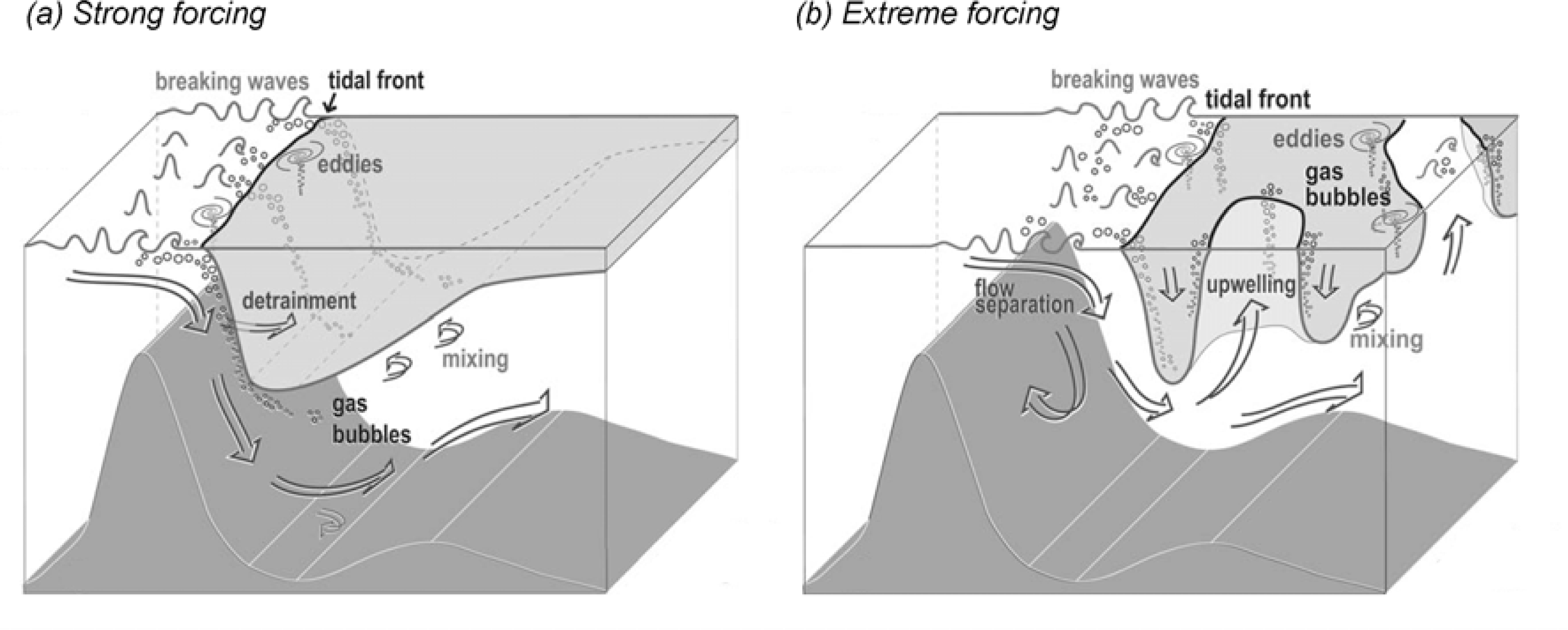
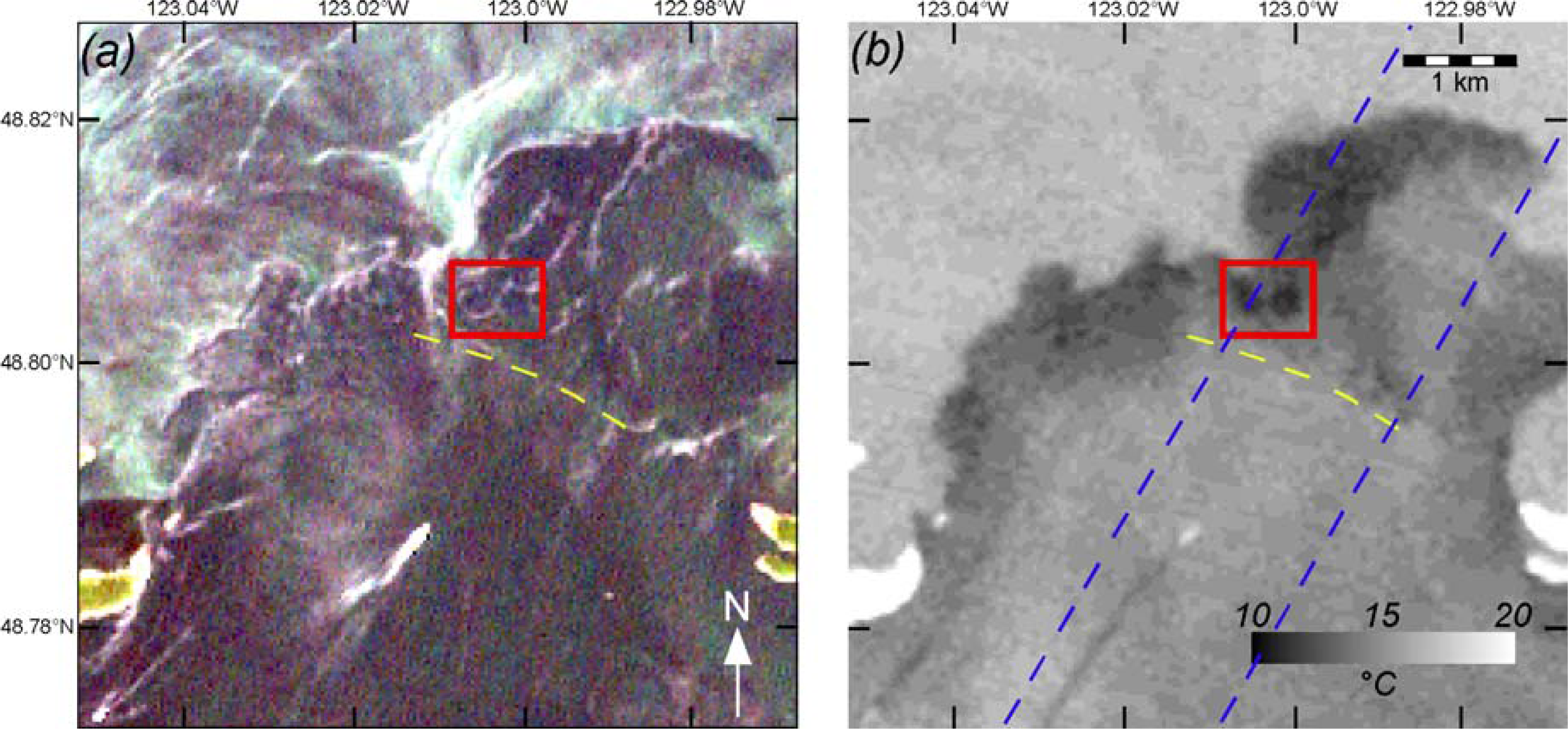
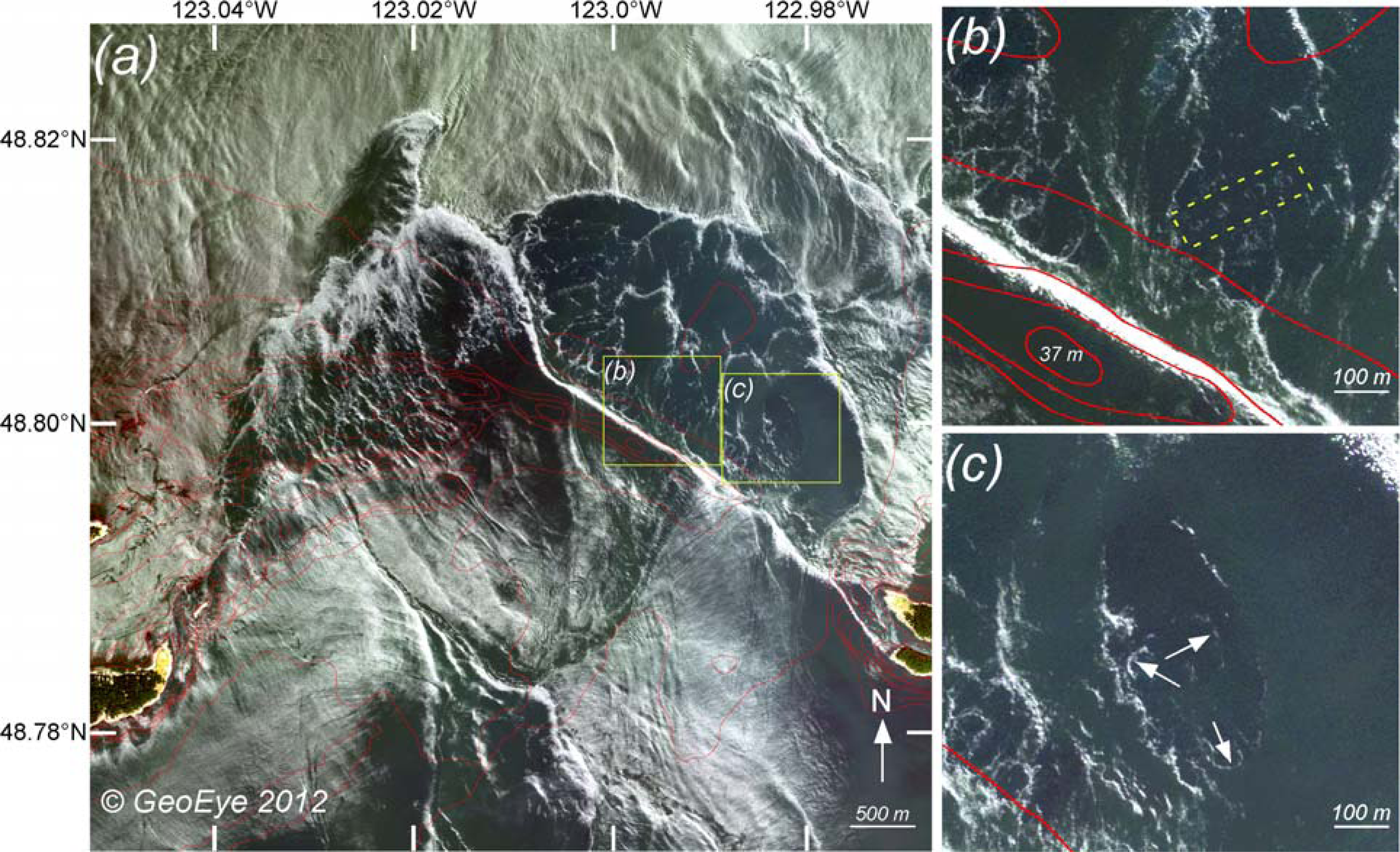
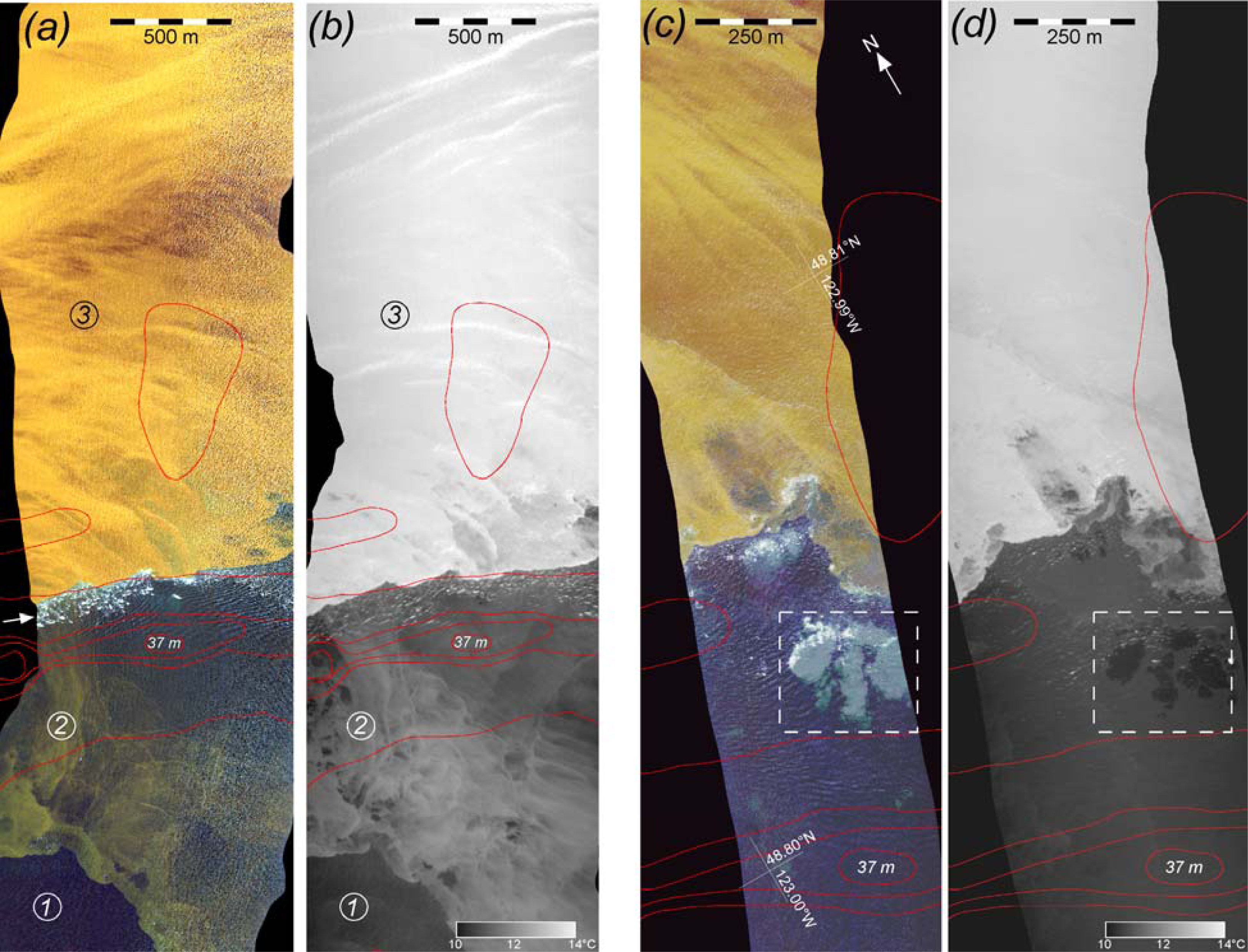
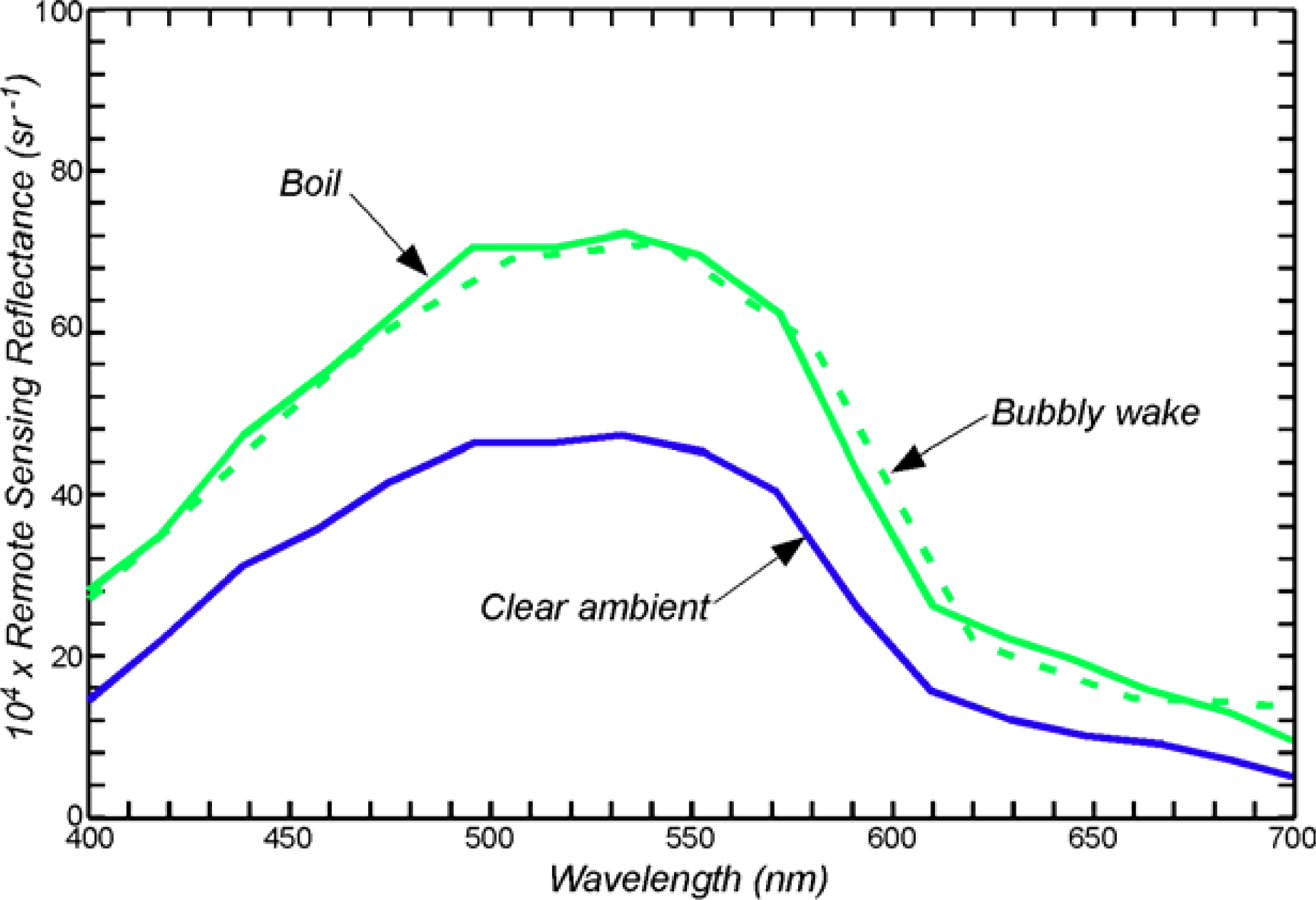
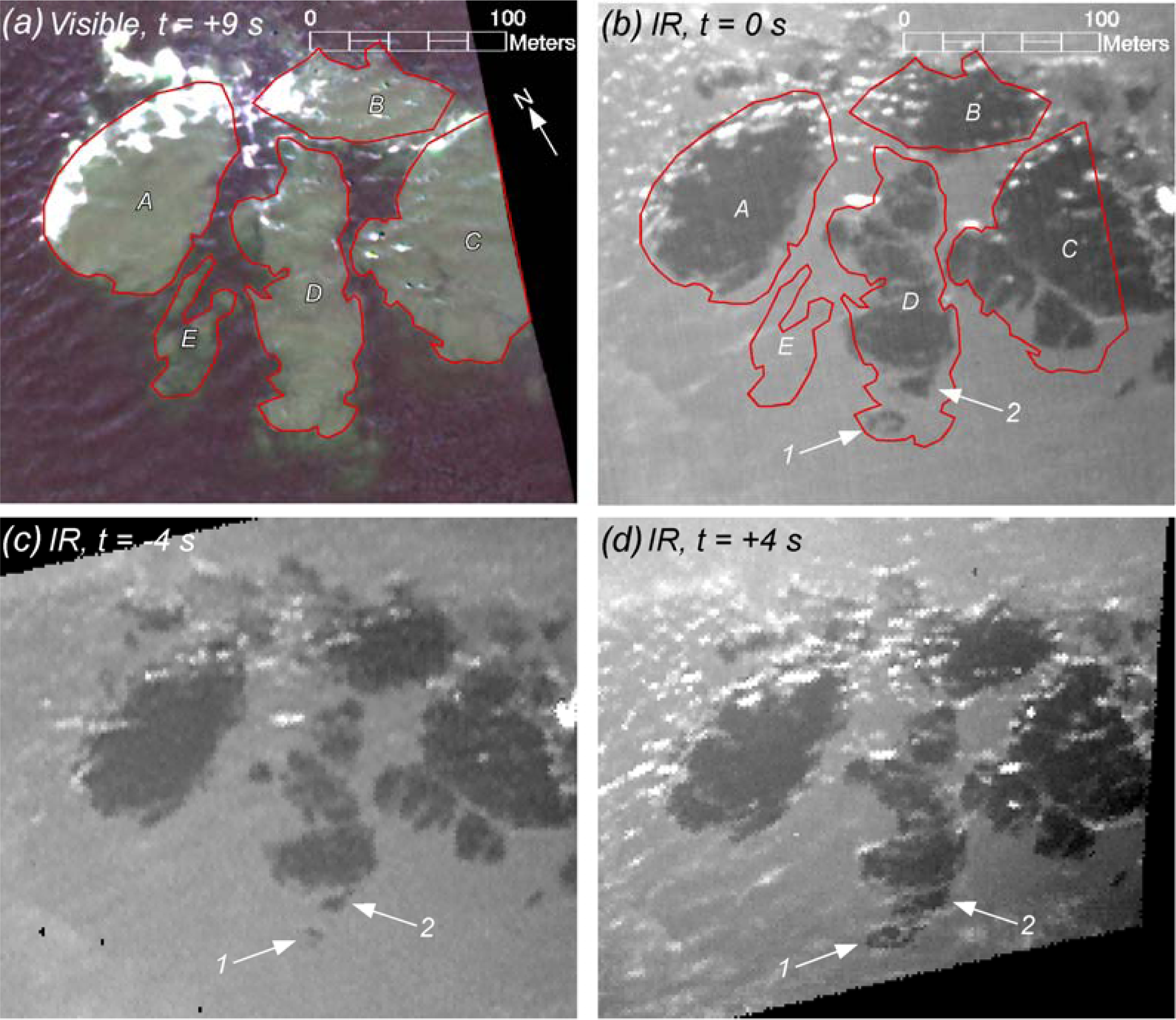



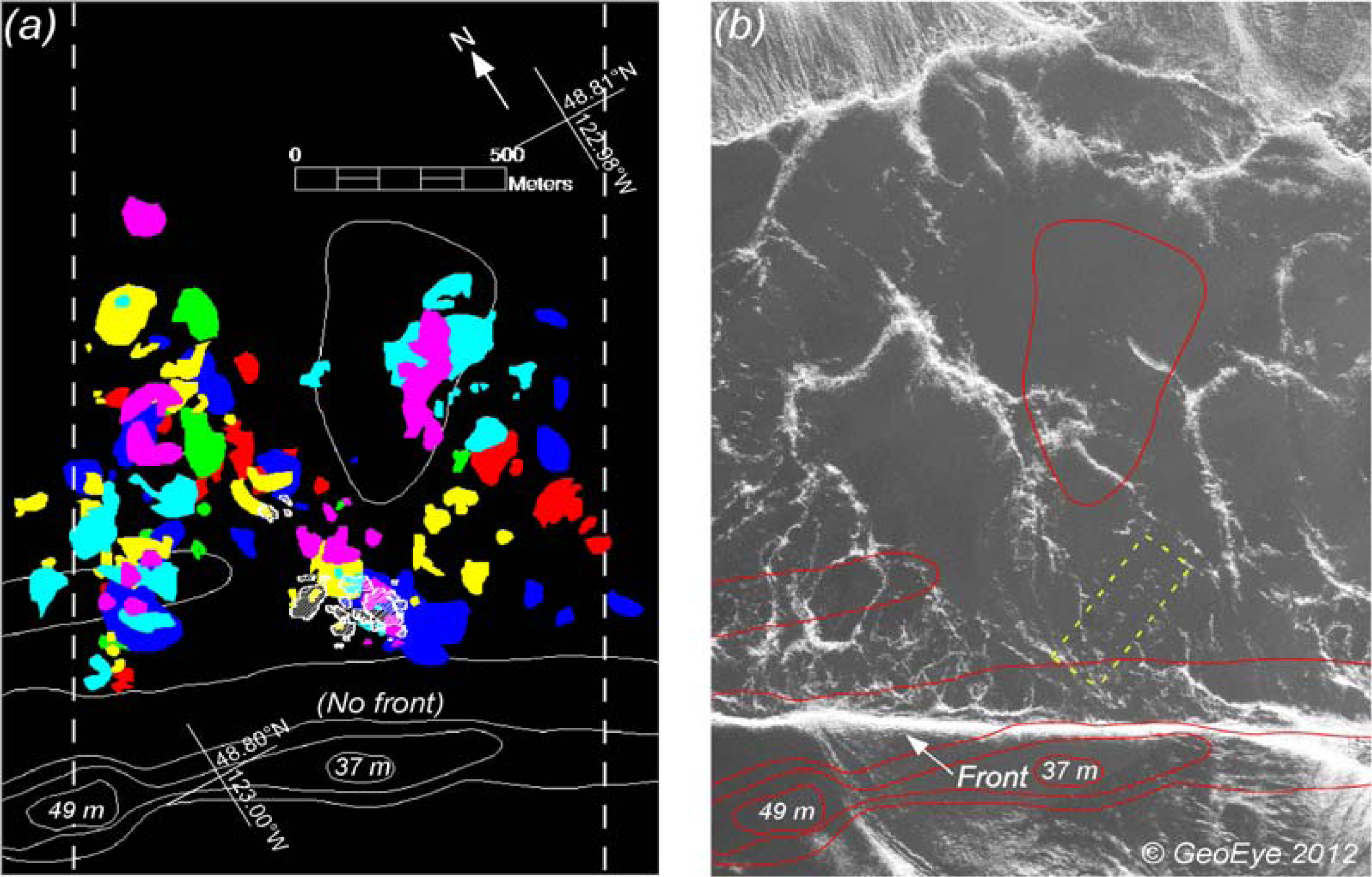
| Platform | Sensor | Pixel Size (m) | Date (Neap Day) | Time (UTC) | Hours after Ebb Slack | Current (m/s) | Wind (m/s) | Fraser River (m3/s) |
|---|---|---|---|---|---|---|---|---|
| LANDSAT ETM+ | Visible/IR | 30/60 | 28 June 2000 (+2) | 1853 | 0.6 | 1.1 | ∼2 (S) | 6,940 |
| GeoEye-1 | Visible | 1.6; 0.4 | 14 July 2012 (+4) | 1934 | 1.7 | 1.0 | <2 (S) | 8,703 |
| Aircraft | IR | 3.5; 7.0 | 18 May 2009 (−1) | 0216–0426 | 0.1 to 2.3 | 1.0 | ∼2 (S) | 4,599 |
| Aircraft | Visible/IR | 0.3; 0.8/1.3; 3.8 | 23 May 2009 (+4) | 1939–2026 | −0.2 to 0.6 | 1.8 | ∼5 (N) | 4,895 |
© 2013 by the authors; licensee MDPI, Basel, Switzerland This article is an open access article distributed under the terms and conditions of the Creative Commons Attribution license (http://creativecommons.org/licenses/by/3.0/).
Share and Cite
Marmorino, G.O.; Smith, G.B.; Miller, W.D. Surface Imprints of Water-Column Turbulence: A Case Study of Tidal Flow over an Estuarine Sill. Remote Sens. 2013, 5, 3239-3258. https://doi.org/10.3390/rs5073239
Marmorino GO, Smith GB, Miller WD. Surface Imprints of Water-Column Turbulence: A Case Study of Tidal Flow over an Estuarine Sill. Remote Sensing. 2013; 5(7):3239-3258. https://doi.org/10.3390/rs5073239
Chicago/Turabian StyleMarmorino, George O., Geoffrey B. Smith, and W. David Miller. 2013. "Surface Imprints of Water-Column Turbulence: A Case Study of Tidal Flow over an Estuarine Sill" Remote Sensing 5, no. 7: 3239-3258. https://doi.org/10.3390/rs5073239
APA StyleMarmorino, G. O., Smith, G. B., & Miller, W. D. (2013). Surface Imprints of Water-Column Turbulence: A Case Study of Tidal Flow over an Estuarine Sill. Remote Sensing, 5(7), 3239-3258. https://doi.org/10.3390/rs5073239




